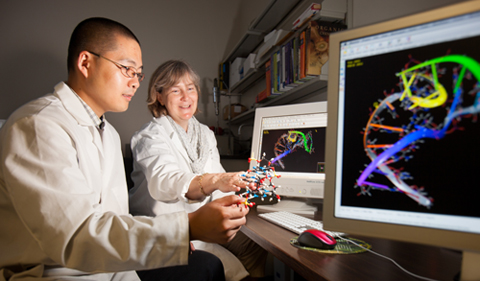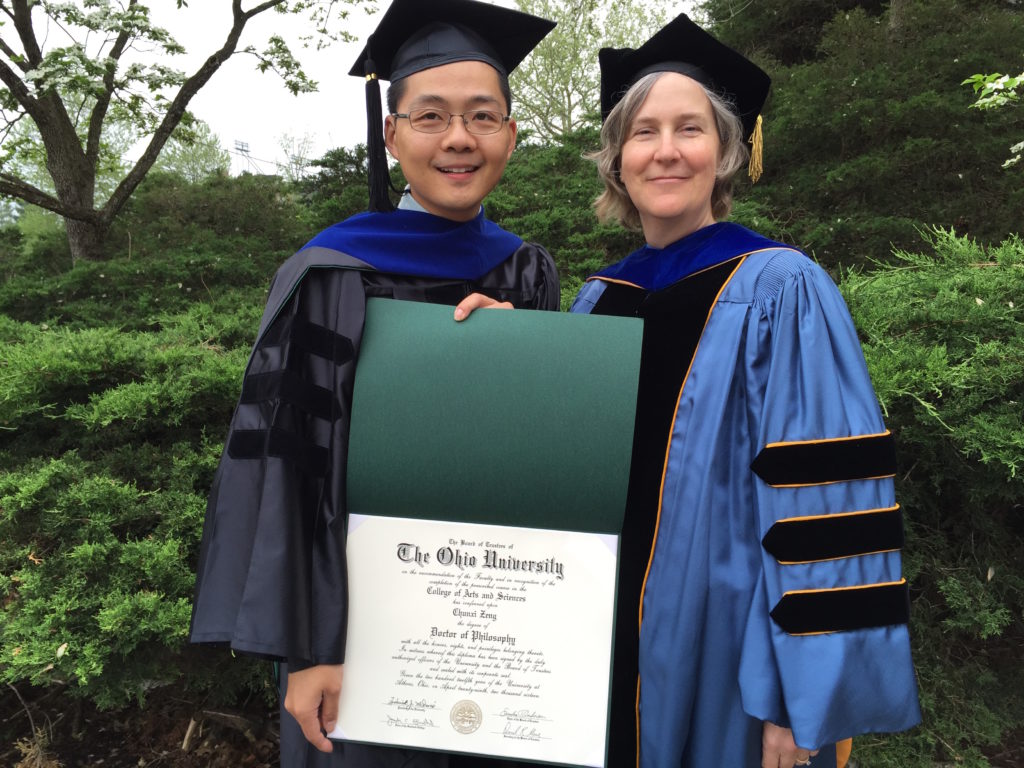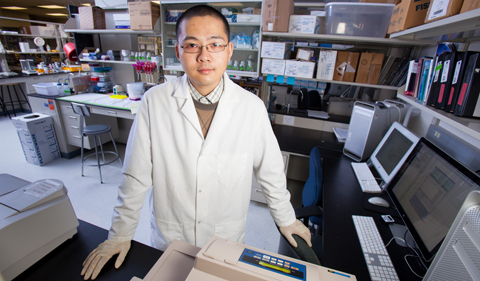
Dr. Chunxi Zeng and Professor Jennifer V. Hines in the Biochemistry Research Facility Ohio University. © Ohio University / Photo by Jonathan Adams
By Kristin M. Distel
Dr. Chunxi Zeng, just awarded a Ph.D. in Chemistry from Ohio University, published an article on “Factors that Influence T box Riboswitch Efficacy and tRNA Affinity” in Bioorganic and Medicinal Chemistry.
In the face of increasingly resistant bacterial strains, Zeng’s work with the T box riboswitch provides hope that many life-threatening infections may be eradicated. Zeng notes that future antibiotics that target the riboswitch could potentially treat bacteria such as “methicillin-resistant staphylococcus aureus [MRSA], a notoriously hard-to-beat bacterium that is resistant to most current antibiotics,” as well as pneumonia caused by a bacterium called Streptococcus pneumoniae.A
Zeng, who also holds a Bachelor of Science degree from Sichuan University in China, is a 2016 graduate of Ohio University’s College of Arts & Sciences.
Developing Assay and Monitoring RNA
Dr. Jennifer Hines served as the article’s Principle Investigator, while S. Zhou and Dr. Stephen Bergmeier, served as co-authors.
Zeng’s research, funded by the National Institutes of Health, involves “finding completely new compounds targeted against a switch in ribonucleic acid (RNA) that turns on or off the expression of essential proteins in bacteria,” explains Hines. “Chunxi developed an assay to monitor this RNA switch effectively, such that we could screen compound libraries to find a compound that would turn off the switch and kill the bacteria.”
“Our research,” Zeng notes, “was designed to develop antibiotics by inhibiting RNA. Currently, physicians are having a hard time treating the spread of multi-drug resistant bacteria.” By researching methods of turning off the riboswitch, Zeng’s research could lead to the development of a new class of antibiotics.

Dr. Chunxi Zeng (left) and Dr. Jennifer Hines commemorate Zeng’s graduation.
Mentoring Students, Publishing Research
The article grew out of a sustained mentorship between Hines and Zeng. Zeng initially applied to OHIO’s doctoral program in chemistry/molecular and cellular biology after researching Hines’ work. His interest in working in her lab and contributing to her research in the booming RNA field was a key factor in his application decision.
“Dr. Hines gives students the freedom to work independently, but she also guides students toward their own goals,” Zeng explains. He notes that Hines’ practice of pairing doctoral students with undergraduates who need mentors is very beneficial for graduates and undergraduates alike.
Zeng also cites Hines’s interest in helping students fine-tune their career paths.
“Dr. Hines wrote a grant so the chemistry department was able to hire a trainer from the American Chemical Society to conduct a chemistry career workshop,” Zeng states. “That is very important for graduate students. Nowadays, the biggest problem in Ph.D. education nationwide is the lack of professional assistance in finding jobs. The workshop will help us prepare for job searches and interviews. Dr. Hines provides great resources for students. I think more workshops will be offered in the future.”
The mentorship between Hines and Zeng culminated in the publication of their article. “Doing research with a great mentor was a really fun process,” Zeng remarks. “I proposed the experimental design. Dr. Hines examined it to make sure it was feasible. After I finished the experiments, we sat together to discuss results and implications. When the conclusions were clear, I wrote the draft of the paper and Dr. Hines polished the writing.” Zeng notes that Hines’ assistance has been invaluable in improving his own research and writing skills.

Dr. Chunxi Zeng in the Biochemistry Research Facility Ohio University. © Ohio University / Photo by Jonathan Adams
Teaching at OHIO
Zeng sees Athens as an ideal place to live and study. “I really like the environment in Athens. It is a beautiful place with many opportunities to enjoy the outdoors. If I’m tired from working in the lab, I take my family to the nearby lakes to relax,” Zeng remarks. “Plus, people here are really friendly.” Zeng notes that as an international student, he feels welcome at OHIO.
During his time at OHIO, Zeng taught CHEM 1220: Principles of Chemistry II as a lecture instructor. He cites this experience as a remarkable opportunity, one that solidified his goal of becoming a chemistry professor. The students’ happiness at grasping particularly difficult concepts was a highlight of teaching the course for Zeng.
“I enjoyed the interaction with students the most,” he recalls. “When you teach students, they are happy when they understand. That intrigued me a lot. I like helping them see something they didn’t see before.”
Future Student Researchers Needed
Zeng hopes to teach and mentor future students in the same way that Hines assisted him throughout his graduate studies.
“We haven’t found the perfect compound yet, but Chunxi’s work will make the future discovery possible,” Hines notes.
Zeng says that future chemistry students are needed to continue this research on the T box riboswitch and develop the findings into antibiotics to help people and treat dangerous infections.
Abstract of Zeng’s Article
The T box riboswitch is an intriguing potential target for antibacterial drug discovery. Found primarily in Gram-positive bacteria, the riboswitch regulates gene expression by selectively responding to uncharged tRNA to control transcription readthrough. Polyamines and molecular crowding are known to specifically affect RNA function, but their effect on T box riboswitch efficacy and tRNA affinity have not been fully characterized. A fluorescence-monitored in vitro transcription assay was developed to readily quantify these molecular interactions and to provide a moderate-throughput functional assay for a comprehensive drug discovery screening cascade. The polyamine spermidine specifically enhanced T box riboswitch readthrough efficacy with an EC50 = 0.58 mM independent of tRNA binding. Molecular crowding, simulated by the addition of polyethylene glycol, had no effect on tRNA affinity for the riboswitch, but did reduce the efficacy of tRNA-induced readthrough. These results indicate that the T box riboswitch tRNA affinity and readthrough efficacy are intricately modulated by environmental factors.


















Comments